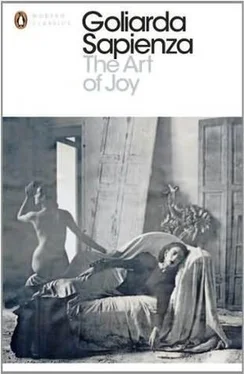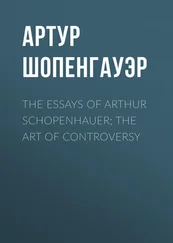And was she ever quick! Within seconds she had rattled off all those words with a smile, while rearranging anything she didn’t feel was quite in order. She drew the curtains, tying them back with a perfect bow, then disappeared from sight, leaving me blinded by the sun, holding that sheet of paper, light and delicate as silk — was the whole house made of silk? — on which a tiny, flawless script told me the times when I was permitted to leave that room. I was allowed to go anywhere, but only during the hours which the pen had written elegantly but firmly on that precious piece of paper.
The entire house wasn’t made of silk, but almost. There were wooden doors and tables, velvet drapes. Outside, however, everything was made of marble: staircases, fountains and statues that, when you least expected them, peeped out from a green niche, not marble of course, but leaves and flowers so lovely that if Mimmo could see them he would be wild with joy. No, better that he wasn’t there to see them; he would have felt bad. He was so proud of his geraniums, even though he grumbled: ‘Eh, princess, there are flowers that are more beautiful. I wish with all my heart that one day you may see them as I did in Catania … If you could see that villa! I was in Catania when I was a soldier. But here, amid the lava, on this meagre scrap of land that we manage to reclaim from it, we have to grow beans, tomatoes, things to eat…’
As Mimmo had wished for her, she now saw those flowers. Sometimes she even touched them, but she didn’t know their names. And after days and days of that silky silence which made her slip from her room into the corridor, and out to the garden, she found the courage to enter the library to find the names of those flowers. She had been right: there were huge volumes full of illustrations where you could find all of them if you looked.
All the names were in Latin. She had to learn them by heart. Now she had something to keep her busy: going from the library to the garden, from the garden to the library to engrave all those strange, difficult names firmly on her mind.
Mimmo always told the truth. Those plants truly were beautiful. If only he were there to break the silence with his sturdy, unhurried voice! Instead, there were only the rushed words of that frivolous creature from the continent, who raced around the room always saying the same things. She didn’t even listen to her anymore. Or rather she stopped listening to her, until she said:
‘The Princess is very pleased to know that you are less sad, and that you go to the library.’
So then, the house wasn’t deserted. They knew what she was doing. Heartened by it, she even dared to enter the music room that day, and with trembling hands, opened the lid of the piano that was at least three times longer than the one in the convent; it wasn’t brown, but black and shiny like the marble columns of the entry staircase. The brilliant gloss was intimidating, but she couldn’t stand that silky silence anymore, so she resumed her practice. Could she be disturbing anyone? At the convent they only allowed her one hour. Her eyes and her fingers were entranced by the whiteness and pliancy of those keys. She barely had to touch them and the sound rang out powerful and pure like an organ. It wasn’t a piano — or maybe, as with the automobile, there were three of them hidden under that long hood …
‘The Princess bids you good morning and asks me to tell you that you have a marvellous touch. She also said that she admires how you have resumed studying and practising the piano, despite your grief over what happened … The Princess would like to know if the food in our house is to your liking and why you don’t take tea at five o’clock. Oh! I see, at the convent they didn’t take tea … Forgive me, signorina , but the Princess has instructed me to measure your shoulders and waist and the circumference of your chest. What’s this you’re wearing under your shirt, signorina ? Why is it so tight? Oh, of course, the convent’s rules. I will report it to the Princess if I may … The Princess asks if you would please — provided you don’t mind too much — she asks that you please take off those bands for a moment so that I can take the exact measurement of your chest … The Princess asked me if you have a photograph of yourself. No photographs? Of course: the convent. Too bad. The Princess asks me to tell you that, knowing how devout you are, she has ordered the driver to take you to Mass tomorrow morning in the village. Only since it’s a two-hour drive she would like to know if you prefer to go to the eight o’clock Mass or the one at noon … at eight? Very well, I’ll tell her.’
How many days had I been there? If the next day was Sunday it must have only been a week or eight days. It seemed like months! Would they leave her by herself for ever? Of course she could read and study, the food was good, but … here she comes again with her “Princess”:
‘The Princess requested that I bring you these three dresses. She asks that you please wear one of these for tea this afternoon, though she is well aware of how important those smocks of yours are to you since they remind you of your vocation. I will come to pick you up since you are not familiar with that wing of the house. She also told me to be sure to tell you not to worry: you only have to wear the dress at five o’clock. After tea, you can go back to wearing your smocks.’
There were three dresses: one pink, one white with gorgeous lace, and a blue one, shiny and flashy, but at least it had the highest neckline. A pity! The pink dress and the white one with the lace appealed to her, but she had to be prudent. So she contented herself by not taking her eyes off them as she dressed and combed her hair — she didn’t have much time. She had never seen anything so beautiful; she felt like crying.
‘What is it? Are you crying, signorina ? Come now, it’s not the end of the world if you wear a dress for one hour. The Princess had expected this. If you knew how intelligent she is, the Princess! She had actually predicted that you would cry if you had to take off that smock. Come, dry those tears. You don’t want to make the Princess sad, do you? She has already suffered so much these past few years: misfortunes one after the other, and then Mother Leonora’s … There, that’s it, go right in. And smile for once, signorina , smile, if only not to remind the Princess of her grief.’
Maybe she was right; I should smile. But prudence stopped me; my lips froze. Confused by Argentovivo’s chatter and surprised that, even if I had wanted to smile, my lips would barely move, I found myself in the middle of a room so spacious, so crammed with tables and sofas and armchairs and settees, that my confusion turned to dismay.
There was no one, only a desert of furniture: here, too, no one was waiting for me. Resigned, I decided to wait for Argentovivo to return, since I would never on my own have found my way back to my room down those corridors and rooms that all looked alike.
‘I assure you, Maman, she’s pretty. A bit solemn but pretty, I assure you!’
Appearing in front of me — where had she come from? — a small, pale face nearly hidden by a mass of fine, blond silky hair (silk here, too) was studying me from head to toe, circling around me just as I did the statues in the garden. Finally, taking me by the hand, she led me safely — how she managed not to overturn the maze of little tables loaded with figurines, boxes, lamps, God only knows! — toward the rear of a narrow, high-backed chair with padded armrests. Seated in the chair was the Princess who had sent me all those messages through Argentovivo’s voice. She was as I had imagined her. Except that when she spoke, had it not been for the little hand that held me, I would have run away.
Читать дальше











